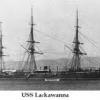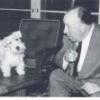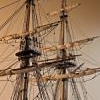-
Posts
2,480 -
Joined
-
Last visited
Reputation Activity
-
 JSGerson got a reaction from CaptainSteve in USS Constitution by xken - Model Shipways - Scale 1:76.8
JSGerson got a reaction from CaptainSteve in USS Constitution by xken - Model Shipways - Scale 1:76.8
Getting back to the numbers on the cutwater, I did a little searching of my collection of build logs and model images of the Constitution. Of the nearly 50 different models I looked at, only about 2 or 3 of them had partial or full depth marks. The best I found was done by Ken Goetz which can be found at Midwest Model Shipwrights. Unfortunately there is no build log associated with the images. So best guess was white transfers or maybe commercially made decals were used.
Jon
-
 JSGerson got a reaction from Canute in USS Constitution by xken - Model Shipways - Scale 1:76.8
JSGerson got a reaction from Canute in USS Constitution by xken - Model Shipways - Scale 1:76.8
Getting back to the numbers on the cutwater, I did a little searching of my collection of build logs and model images of the Constitution. Of the nearly 50 different models I looked at, only about 2 or 3 of them had partial or full depth marks. The best I found was done by Ken Goetz which can be found at Midwest Model Shipwrights. Unfortunately there is no build log associated with the images. So best guess was white transfers or maybe commercially made decals were used.
Jon
-
 JSGerson got a reaction from Canute in USS Constitution by xken - Model Shipways - Scale 1:76.8
JSGerson got a reaction from Canute in USS Constitution by xken - Model Shipways - Scale 1:76.8
I've not done bow numbering before. The Rattlesnake is my first POB as well my first 3 masted ship. My best guess is either the transfer lettering (which you've had poor results so far) or homemade decals. The problem with decals in this case is they have to be white and you can't print white. Printing on paper, cutting them to size, and having them match the background exactly would be extremely difficult and I don't think they would look good. That leaves the transfers. I think you might have better luck with them here because you have more working room. You might want to check other build logs and see what they have done. Sorry I couldn't of been of more help in this case.
Jon
-
 JSGerson got a reaction from Canute in USS Constitution by xken - Model Shipways - Scale 1:76.8
JSGerson got a reaction from Canute in USS Constitution by xken - Model Shipways - Scale 1:76.8
You used the same method to attached the nameplate as I did for my Rattlesnake (post 337) except that I made a decal to be placed on wood instead of printing on paper. It was then I realized that printers cannot print white. Obviously in the Constitution case, the background on the nameplate is black and the only way to get white printing is to do it the way you did. I just never thought about it before. Very nice job
Jon
-
 JSGerson got a reaction from CaptainSteve in USS Constitution by xken - Model Shipways - Scale 1:76.8
JSGerson got a reaction from CaptainSteve in USS Constitution by xken - Model Shipways - Scale 1:76.8
I've not done bow numbering before. The Rattlesnake is my first POB as well my first 3 masted ship. My best guess is either the transfer lettering (which you've had poor results so far) or homemade decals. The problem with decals in this case is they have to be white and you can't print white. Printing on paper, cutting them to size, and having them match the background exactly would be extremely difficult and I don't think they would look good. That leaves the transfers. I think you might have better luck with them here because you have more working room. You might want to check other build logs and see what they have done. Sorry I couldn't of been of more help in this case.
Jon
-
 JSGerson got a reaction from CaptainSteve in USS Constitution by xken - Model Shipways - Scale 1:76.8
JSGerson got a reaction from CaptainSteve in USS Constitution by xken - Model Shipways - Scale 1:76.8
You used the same method to attached the nameplate as I did for my Rattlesnake (post 337) except that I made a decal to be placed on wood instead of printing on paper. It was then I realized that printers cannot print white. Obviously in the Constitution case, the background on the nameplate is black and the only way to get white printing is to do it the way you did. I just never thought about it before. Very nice job
Jon
-
 JSGerson got a reaction from GLakie in USS Constitution by xken - Model Shipways - Scale 1:76.8
JSGerson got a reaction from GLakie in USS Constitution by xken - Model Shipways - Scale 1:76.8
I've not done bow numbering before. The Rattlesnake is my first POB as well my first 3 masted ship. My best guess is either the transfer lettering (which you've had poor results so far) or homemade decals. The problem with decals in this case is they have to be white and you can't print white. Printing on paper, cutting them to size, and having them match the background exactly would be extremely difficult and I don't think they would look good. That leaves the transfers. I think you might have better luck with them here because you have more working room. You might want to check other build logs and see what they have done. Sorry I couldn't of been of more help in this case.
Jon
-
 JSGerson got a reaction from GLakie in USS Constitution by xken - Model Shipways - Scale 1:76.8
JSGerson got a reaction from GLakie in USS Constitution by xken - Model Shipways - Scale 1:76.8
You used the same method to attached the nameplate as I did for my Rattlesnake (post 337) except that I made a decal to be placed on wood instead of printing on paper. It was then I realized that printers cannot print white. Obviously in the Constitution case, the background on the nameplate is black and the only way to get white printing is to do it the way you did. I just never thought about it before. Very nice job
Jon
-
 JSGerson got a reaction from Martin W in Rattlesnake by KenW - FINISHED - Model Shipways - Scale 1:64 - American Privateer
JSGerson got a reaction from Martin W in Rattlesnake by KenW - FINISHED - Model Shipways - Scale 1:64 - American Privateer
Great job, I knew you could do it! There, now don't you feel better knowing you did it and didn't use the kit's cast metal part?
Jonathan
-
 JSGerson got a reaction from CaptainSteve in USS Constitution by xken - Model Shipways - Scale 1:76.8
JSGerson got a reaction from CaptainSteve in USS Constitution by xken - Model Shipways - Scale 1:76.8
Just being picky, but I assume you drilled a 0.132" hole in the twisted end and not the 1.32" as indicated...just saying. 8-)
Jonathan
P.S. Beautiful workmanship and documentation of it.
-
 JSGerson got a reaction from Canute in USS Constitution by xken - Model Shipways - Scale 1:76.8
JSGerson got a reaction from Canute in USS Constitution by xken - Model Shipways - Scale 1:76.8
Just being picky, but I assume you drilled a 0.132" hole in the twisted end and not the 1.32" as indicated...just saying. 8-)
Jonathan
P.S. Beautiful workmanship and documentation of it.
-
 JSGerson got a reaction from GLakie in USS Constitution by xken - Model Shipways - Scale 1:76.8
JSGerson got a reaction from GLakie in USS Constitution by xken - Model Shipways - Scale 1:76.8
Just being picky, but I assume you drilled a 0.132" hole in the twisted end and not the 1.32" as indicated...just saying. 8-)
Jonathan
P.S. Beautiful workmanship and documentation of it.
-
 JSGerson got a reaction from usedtosail in Rattlesnake by JSGerson - FINISHED - Mamoli - 1:64 - Using Robert Hunt’s practicum
JSGerson got a reaction from usedtosail in Rattlesnake by JSGerson - FINISHED - Mamoli - 1:64 - Using Robert Hunt’s practicum
David - I chose the Mamoli kit because the practicum was based on it, although you can use the practicum with MS kit for the most part. I had no idea what MS kit looked like at that time. I finally purchased the MS plans on one of MS's many sales and got it cheap and downloaded their building instructions from their website.
The structure of the two sets of plans are completely different. I like the Mamoli plans because it gives more detail diagrams, but I have to look at multiple diagrams to get a complete picture of what I have to do. The instructions are written on the plans and for me difficult to read - I wear strong tri-focals using an eye loupe as I am blind as a bat without these optics. Being a newbe, this has been a problem for me especially the rigging. There are numerous places where I could have done things sooner, off the model, and easier had I understood and realized it.
The MS plans give a more complete picture but less detailed breakdown diagrams and no sense of order of construction with individual instructions all over the place on the plans and instruction booklet. So I use both now, but as you have surely read on my log, there are differences in the details. Then I have Harold Hahn's plans (which Bob's practicum is based on) and through another builder, the plans for the Smithsonian model. Again some differences in detail in each.
If you can, get the wood supplement described in the practicum. I got mine at Hobby Mills before Jeff Hayes retired from the business. Jason Clark's Crown Timberyard has picked up the slack and provides a very nice product. If he doesn't have the list of replacement wood and sizes, I can provide that based on the invoice of what I got.
DocBlake - Thanks for the like. I can understand why you put your Rattler aside, that transom can be very frustrating if something goes wrong especially if you don't know what it was that went wrong. When you get the courage to go at it again, I'll be watching.
Jonathan
-
 JSGerson got a reaction from cristikc in Rattlesnake by JSGerson - FINISHED - Mamoli - 1:64 - Using Robert Hunt’s practicum
JSGerson got a reaction from cristikc in Rattlesnake by JSGerson - FINISHED - Mamoli - 1:64 - Using Robert Hunt’s practicum
Installing the Mizzen Boom
The first order of business was rigging the parral. Before installation, the parral line was attached to one of the boom’s jaws with a pseudo eye splice through the pre drilled hole in the jaw, and five beads were threaded on. The boom was positioned and the line was threaded through the hole in the other jaw and tied with a simple knot and glued. Now it was just a matter of hooking everything up and adding the two blocks to the pre drilled holes on the mast cap and a block each to the pre-drilled holes on the deck on either side of the mast. Sounds simple, of course I’m describing all the failed attempts due to dropped and lost hooks, failed block stroppings, wrong length of line used, etc. You know the drill.
-
 JSGerson got a reaction from CaptainSteve in Rattlesnake by JSGerson - FINISHED - Mamoli - 1:64 - Using Robert Hunt’s practicum
JSGerson got a reaction from CaptainSteve in Rattlesnake by JSGerson - FINISHED - Mamoli - 1:64 - Using Robert Hunt’s practicum
David - I chose the Mamoli kit because the practicum was based on it, although you can use the practicum with MS kit for the most part. I had no idea what MS kit looked like at that time. I finally purchased the MS plans on one of MS's many sales and got it cheap and downloaded their building instructions from their website.
The structure of the two sets of plans are completely different. I like the Mamoli plans because it gives more detail diagrams, but I have to look at multiple diagrams to get a complete picture of what I have to do. The instructions are written on the plans and for me difficult to read - I wear strong tri-focals using an eye loupe as I am blind as a bat without these optics. Being a newbe, this has been a problem for me especially the rigging. There are numerous places where I could have done things sooner, off the model, and easier had I understood and realized it.
The MS plans give a more complete picture but less detailed breakdown diagrams and no sense of order of construction with individual instructions all over the place on the plans and instruction booklet. So I use both now, but as you have surely read on my log, there are differences in the details. Then I have Harold Hahn's plans (which Bob's practicum is based on) and through another builder, the plans for the Smithsonian model. Again some differences in detail in each.
If you can, get the wood supplement described in the practicum. I got mine at Hobby Mills before Jeff Hayes retired from the business. Jason Clark's Crown Timberyard has picked up the slack and provides a very nice product. If he doesn't have the list of replacement wood and sizes, I can provide that based on the invoice of what I got.
DocBlake - Thanks for the like. I can understand why you put your Rattler aside, that transom can be very frustrating if something goes wrong especially if you don't know what it was that went wrong. When you get the courage to go at it again, I'll be watching.
Jonathan
-
 JSGerson got a reaction from Martin W in Rattlesnake by JSGerson - FINISHED - Mamoli - 1:64 - Using Robert Hunt’s practicum
JSGerson got a reaction from Martin W in Rattlesnake by JSGerson - FINISHED - Mamoli - 1:64 - Using Robert Hunt’s practicum
David - I chose the Mamoli kit because the practicum was based on it, although you can use the practicum with MS kit for the most part. I had no idea what MS kit looked like at that time. I finally purchased the MS plans on one of MS's many sales and got it cheap and downloaded their building instructions from their website.
The structure of the two sets of plans are completely different. I like the Mamoli plans because it gives more detail diagrams, but I have to look at multiple diagrams to get a complete picture of what I have to do. The instructions are written on the plans and for me difficult to read - I wear strong tri-focals using an eye loupe as I am blind as a bat without these optics. Being a newbe, this has been a problem for me especially the rigging. There are numerous places where I could have done things sooner, off the model, and easier had I understood and realized it.
The MS plans give a more complete picture but less detailed breakdown diagrams and no sense of order of construction with individual instructions all over the place on the plans and instruction booklet. So I use both now, but as you have surely read on my log, there are differences in the details. Then I have Harold Hahn's plans (which Bob's practicum is based on) and through another builder, the plans for the Smithsonian model. Again some differences in detail in each.
If you can, get the wood supplement described in the practicum. I got mine at Hobby Mills before Jeff Hayes retired from the business. Jason Clark's Crown Timberyard has picked up the slack and provides a very nice product. If he doesn't have the list of replacement wood and sizes, I can provide that based on the invoice of what I got.
DocBlake - Thanks for the like. I can understand why you put your Rattler aside, that transom can be very frustrating if something goes wrong especially if you don't know what it was that went wrong. When you get the courage to go at it again, I'll be watching.
Jonathan
-
 JSGerson got a reaction from KenW in Rattlesnake by JSGerson - FINISHED - Mamoli - 1:64 - Using Robert Hunt’s practicum
JSGerson got a reaction from KenW in Rattlesnake by JSGerson - FINISHED - Mamoli - 1:64 - Using Robert Hunt’s practicum
Installing the Mizzen Boom
The first order of business was rigging the parral. Before installation, the parral line was attached to one of the boom’s jaws with a pseudo eye splice through the pre drilled hole in the jaw, and five beads were threaded on. The boom was positioned and the line was threaded through the hole in the other jaw and tied with a simple knot and glued. Now it was just a matter of hooking everything up and adding the two blocks to the pre drilled holes on the mast cap and a block each to the pre-drilled holes on the deck on either side of the mast. Sounds simple, of course I’m describing all the failed attempts due to dropped and lost hooks, failed block stroppings, wrong length of line used, etc. You know the drill.
-
 JSGerson got a reaction from Geoff Matson in Rattlesnake by JSGerson - FINISHED - Mamoli - 1:64 - Using Robert Hunt’s practicum
JSGerson got a reaction from Geoff Matson in Rattlesnake by JSGerson - FINISHED - Mamoli - 1:64 - Using Robert Hunt’s practicum
There is no consensus that I could find that states which is the best order to add the yards and booms so I decided to work again from the stern forward, bottom to top, one level at a time. In other words, add the mizzen booms, then the lowest yards working forward. This would be followed by the midlevel yards aft to forward and finally the top masts aft to forward. Whether this is the optimum way to do this or not, I don’t know. We’ll see.
Mizzen Boom
Thus the first order of business was to rig the mizzen boom. There was more stuff on this piece than I realized. It required 12 blocks; some were double blocks and others required hooks. Speaking of blocks with hooks, the Mamoli plans show that the Guy Pendant goes to a tied block on the taffrail (the railing above the transom) eyebolt. The MS drawing indicates that the block is hooked to the eyebolt. I couldn’t use Antscherl’s book as a guide because the model he was describing only had a gaff, no boom. However Petersson’s “Rigging Period Ship Models” did show that blocks attached to the hull were hooked. So, I decided to go with the hooked block because I thought that is what was probable used, plus I thought it looked better (what do I know?).
Mizzen Boom Parral
Another difference between the plans is the boom and gaff parrals. Mamoli just uses a loop of rope while MS shows a single rope with parrals and no ribs. Checking my sources, James Lees’ “The Masting and Rigging of English Ships of War 1625 – 1860” confirmed that no parral ribs were used for the boom and gaff but made no mention (that I could find) of using just rope. Maybe no parrals were used on smaller ships, I don’t know, so again I chose to follow MS. Lees stated that these trucks were about 3/8 the width of the boom. Since the boom and gaff were 0.10” and 0.09” at their widest point meant their trucks were 0.075 and 0.034” respectfully. I purchased a small bag of beads from a local bead shop. I got the smallest size they had. The bag was marked “size 11” which meant nothing to me. I measured them when I got home – 0.08”. These guys are tiny and I don’t think I could handle, let alone thread, anything smaller, so that’s what I used. One other thing, real trucks tend to be as wide if not wider than their diameter; these beads are a bit narrower. That raised the next question, what size is the rope used to thread the trucks? The only places where I found which described the parral rope size was Antscherl who used 2” (circumference) line (0.01” mini-rope) for his gaff, and the Smithsonian’s plans which showed 1½“ line (0.007”). Since I have both the kit’s 0.009” rope and Syren’s 0.008” rope, I had a choice, not that anyone could see the difference; I chose Syren, it looks better.
-
 JSGerson got a reaction from Martin W in Rattlesnake by JSGerson - FINISHED - Mamoli - 1:64 - Using Robert Hunt’s practicum
JSGerson got a reaction from Martin W in Rattlesnake by JSGerson - FINISHED - Mamoli - 1:64 - Using Robert Hunt’s practicum
Thanks for dropping by Ken (xKen). Buying a milling machine will remain on my wish list for now. As I have mentioned, all of the woodwork on this build is complete and I won't start the Frigate Constitution until I've completed my Rattlesnake - I don't need any more diversions to its completion, I go slow enough. That gives me time to figure out exactly what I need vs what I want; the two, contrary to popular belief, are not necessarily the same.
Jonathan
-
 JSGerson got a reaction from Martin W in Rattlesnake by JSGerson - FINISHED - Mamoli - 1:64 - Using Robert Hunt’s practicum
JSGerson got a reaction from Martin W in Rattlesnake by JSGerson - FINISHED - Mamoli - 1:64 - Using Robert Hunt’s practicum
Installing the Mizzen Boom
The first order of business was rigging the parral. Before installation, the parral line was attached to one of the boom’s jaws with a pseudo eye splice through the pre drilled hole in the jaw, and five beads were threaded on. The boom was positioned and the line was threaded through the hole in the other jaw and tied with a simple knot and glued. Now it was just a matter of hooking everything up and adding the two blocks to the pre drilled holes on the mast cap and a block each to the pre-drilled holes on the deck on either side of the mast. Sounds simple, of course I’m describing all the failed attempts due to dropped and lost hooks, failed block stroppings, wrong length of line used, etc. You know the drill.
-
 JSGerson got a reaction from Ryland Craze in Rattlesnake by JSGerson - FINISHED - Mamoli - 1:64 - Using Robert Hunt’s practicum
JSGerson got a reaction from Ryland Craze in Rattlesnake by JSGerson - FINISHED - Mamoli - 1:64 - Using Robert Hunt’s practicum
Installing the Mizzen Boom
The first order of business was rigging the parral. Before installation, the parral line was attached to one of the boom’s jaws with a pseudo eye splice through the pre drilled hole in the jaw, and five beads were threaded on. The boom was positioned and the line was threaded through the hole in the other jaw and tied with a simple knot and glued. Now it was just a matter of hooking everything up and adding the two blocks to the pre drilled holes on the mast cap and a block each to the pre-drilled holes on the deck on either side of the mast. Sounds simple, of course I’m describing all the failed attempts due to dropped and lost hooks, failed block stroppings, wrong length of line used, etc. You know the drill.
-
 JSGerson got a reaction from DocBlake in Rattlesnake by JSGerson - FINISHED - Mamoli - 1:64 - Using Robert Hunt’s practicum
JSGerson got a reaction from DocBlake in Rattlesnake by JSGerson - FINISHED - Mamoli - 1:64 - Using Robert Hunt’s practicum
Finally, a coat of Wipe-On-Poly was applied to the completed yards and booms. On a final point, a milestone has been reached – All of the wood working on this model is now complete (as far as I know). All that is left is the remaining rigging which continues with the yards, off the model.
-
 JSGerson got a reaction from Jack12477 in Rattlesnake by JSGerson - FINISHED - Mamoli - 1:64 - Using Robert Hunt’s practicum
JSGerson got a reaction from Jack12477 in Rattlesnake by JSGerson - FINISHED - Mamoli - 1:64 - Using Robert Hunt’s practicum
The 42 chocks were next. They were made in 6 steps per chock. Yes, this was tedious and exacting work although that actual process didn’t eat up too much – 2 to 3 minutes per chock or 1½ - 2 hrs total once you got into the rhythm. I usually stopped after 6 chocks to apply them to the yard to break the monotony. Using white glue, they were applied to the appropriate positions on the various yards.
Measure 3/32” from the end of a 1/16” square piece of stock walnut and make a pencil mark File a corner off leaving about 1/64” (eyeballed) from the adjacent corner and the pencil mark with a flat file File the resulting surface to get an inward curve with a round face file Round off the two corners of the inward curve to the 1/64” faces Cut the chock off from the stock at the pencil mark using a miter box. From experience, I have found that using a knife does not always produce a square cut. File a groove on the bottom of the chuck so it will sit comfortable on the round surface of the yard or leave flat when placing it on flat surfaces of the yard Note: for some of the smaller diameter yards, 1/16” x 3/64” stock walnut was used
PSA: If you every drop a chock onto a messy work bench (like mine) or on the floor and you can’t find it in a few minutes, let it go because it’s gone man, it’s just gone. Make a new one; it’s faster than looking for the lost one.
-
 JSGerson got a reaction from DocBlake in Rattlesnake by JSGerson - FINISHED - Mamoli - 1:64 - Using Robert Hunt’s practicum
JSGerson got a reaction from DocBlake in Rattlesnake by JSGerson - FINISHED - Mamoli - 1:64 - Using Robert Hunt’s practicum
The boom also has a cleat, a sheave, chocks, and a couple of eyebolts that needed to be installed. The gaff just had an eyebolt and cleats. Having made cleats for the Gallows Bits a while back I can tell you they are a pain in the butt and I wasn’t really happy with the way they looked. Chuck Passaro of Syren Ship Model Co. solved that problem with his laser cut cleats blanks. Using the 5mm cleat blank, I added a pin and finished the carving it (smoothing and rounding off the edges). Because this cleat already had a very small gluing surface, and it was going on a curved surface, a mechanical connection was required. After all, a line was to be tied to it and I didn’t want it to be pulled off. BTY, with the pin in place, holding the cleat was made carving it a little easier. Once a hole was positioned and drilled on the underside of the boom, the pin was trimmed to a shorter length and inserted and glued into place.
-
 JSGerson got a reaction from GLakie in USS Constitution by usedtosail - FINISHED - Model Shipways - scale 1/76
JSGerson got a reaction from GLakie in USS Constitution by usedtosail - FINISHED - Model Shipways - scale 1/76
David, if I might Interject into your conversation, I too am a fan of Robert Hunt's practicums. They have a lot of useful stuff and I could not have built, let alone started building my Rattlesnake (my first square rigger build) without it. Just be aware that Bob is human and not perfect (he has a lot of idiosyncrasies that others might attest to) and therefore his practicums (at least the Rattlesnake's) have errors which I have pointed out in my log. Some of his dimensions were wrong as well as some of his building sequences were not fully thought out (my opinion). Double check everything and get second opinions on how to accomplish things from other build logs. He does state in the Rattlesnake practicum that there maybe better ways of doing things. I look forward to following your build log as the Conny is my planned second build and using his practicum.













